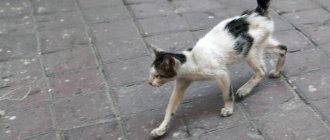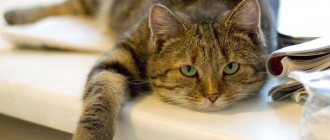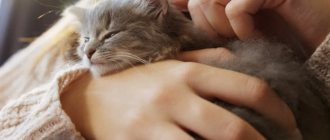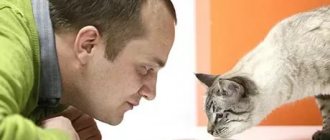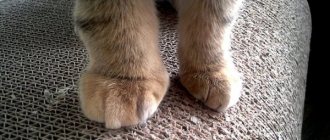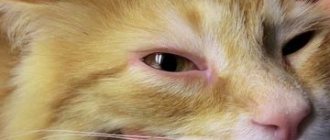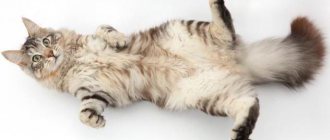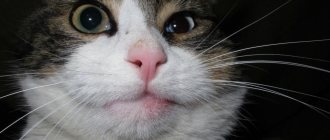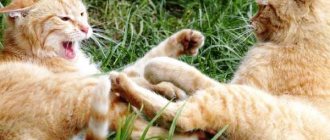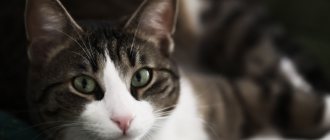Dysbacteriosis in cats is a disease characterized by a violation of the mobile balance of microflora that normally populates the intestines. If in a healthy cat in the distal parts of the small intestine and in the large intestine lactobacilli, anaerobic streptococci, E. coli, enterococci and other microorganisms predominate, then with dysbacteriosis the balance between these microorganisms is disturbed, putrefactive, iodophilic or fermentative flora, fungi, mainly of the Gandida type, develop abundantly . With dysbacteriosis in cats, there are microorganisms in the intestines that should not normally be present; a large number of microbes and fungi are detected in the contents of the proximal parts of the small intestine and in the stomach. Instead of non-pathogenic strains of E. coli, pathogenic ones are often found in cats. Thus, with dysbiosis, quantitative and qualitative changes in the composition of microbial associations in the gastrointestinal tract of a cat are observed.
Etiology. Clinical dysbiosis in cats is caused by all diseases and conditions that are accompanied by disruption of the processes of hydrolysis and absorption of nutrients in the intestine - dyspepsia, gastritis (gastritis in cats), pancreatitis (pancreatitis in cats), hepatitis (liver disease in cats), enteritis, poisoning in a cat (Poisoning in a cat: first aid), colitis (colitis in cats), gastroenteritis (gastroenteritis in cats), worms in cats, severe stress, hormonal imbalance associated with pregnancy, the use of contraceptives (contrasex), infectious diseases - (feline panleukopenia , salmonellosis in cats, infectious peritonitis in cats, infectious rhinotracheitis - herpes in cats), parasitic (coccidiosis in cats, giardiasis in cats) kidney disease in cats, oncological diseases of the stomach and intestines (oncology in cats).
Often the cause of intestinal dysbiosis in cats is long-term uncontrolled use of antibiotics, sulfonamides, nitrofurans and other antimicrobial agents that suppress normal intestinal microflora and promote the development of those microorganisms that are resistant to these substances.
Pathogenesis. The mechanism of development of dysbiosis in cats is as follows: there is a disruption in the antagonistic activity of the intestinal microflora towards pathogenic and putrefactive microorganisms, its participation in the digestive processes (due to its own enzymes) and the synthesis of certain vitamins. Toxic waste products of microorganisms and the products of breakdown of nutrients formed in large quantities - organic acids, aldehydes, indole, skatole, hydrogen sulfide, histamine and others, irritate the intestinal wall. An allergic reaction occurs in the cat's body to unusual products of the breakdown of nutrients, as well as to antigens of bacteria and fungi.
Clinical picture. Dysbacteriosis in cats is characterized by clinical signs of dyspepsia or enteritis. The cat's appetite is reduced, and with severe spastic pain in the intestines it disappears completely (loss of appetite in the cat). An unpleasant putrid odor emanates from the mouth (bad breath in a cat), vomiting or the urge to vomit is possible (vomiting in a cat). Dysbacteriosis in cats is often accompanied by the development of intestinal flatulence (bloating in a cat). The cat's abdomen is sharply increased in volume, and upon palpation it is very tense and painful.
Diarrhea that occurs (diarrhea in a cat) may alternate with constipation (constipation in a cat (coprostasis). Feces have a sharp putrid or sour odor and contain undigested food particles. As a result of disturbances in the activity of the gastrointestinal tract, the cat experiences symptoms of general intoxication of the body - lethargy, apathy, depression.
With a long course of dysbacteriosis, it is complicated by hypovitaminosis, especially in the body there is not enough B vitamins.
Some types of intestinal dysbiosis, especially staphylococcal, candidomycosis, and proteus, can become generalized and even cause sepsis in the cat.
Diagnosis. To diagnose the disease in modern veterinary clinics, the following methods are used: biochemical blood test (cat blood test), fecal examination and endoscopic examination. The diagnosis of dysbacteriosis in cats is confirmed by repeated studies of fecal microflora (mainly based on the results of coprogram).
If gastrointestinal pathology is suspected, radiography and ultrasound of the abdominal cavity (ultrasound in a cat) are performed.
Differential diagnosis. Veterinary specialists, when carrying out differential diagnosis, must exclude dysbiosis that occurs against the background of systematic nutritional errors (established on the basis of the collected anamnesis) and dysbacteriosis accompanying acute and chronic infectious and invasive diseases.
Treatment. When dysbacteriosis is established in a cat, stop using antibacterial agents that contribute to its development. They carry out a set of activities aimed at:
- Purgation.
- Improving the functioning of the gastrointestinal tract.
- Restoration of beneficial microflora in the intestines.
- Immune support.
- Mental stabilization.
We cleanse the intestines of toxins and waste by prescribing enterosorbents (Smecta, Lignitin). Some veterinary specialists carry out intestinal cleansing by prescribing phytoelite: a tablet 4-5 times a day (first week) and 3 times a day (second week). In the third week, the dose is reduced to ½ tablet, which should be given once a day. In the last, fourth week of treatment, give 1 tablet once a week.
To improve the functioning of the digestive organs, we use enzymatic preparations - Mezim, Cholenzym.
If your cat has diarrhea, give rice decoctions.
In order to restore the population of beneficial microorganisms in the intestines, we treat with probiotics. Among the probiotics, veterinary specialists usually prescribe the following:
Lactobifid, Lactoferon, Fortiflora, Linex, Bifidumbacterin, Baktisubtil
These products should be used under the supervision of a veterinarian.
What are probiotics?
Probiotics are beneficial microorganisms (yeast and bacteria) that normalize intestinal function, restoring the composition and activity of natural microflora. There are a number of negative factors that provoke the development of the disease:
- The use of low-quality feed, a sharp change in diet.
- Vaccinations are necessary for a cat, but can become very stressful for the animal.
- A course of steroid drugs (for example, prednisolone) or antibiotics. After using strong antibiotics, probiotics for a cat are extremely necessary, since without them your cat will likely develop severe dysbiosis, the consequences of which we will discuss below.
- Any surgical intervention.
- Inflammatory bowel diseases.
- Renal failure, pancreatitis and hyperthyroidism, urinary tract pathology.
Helping a cat after taking antibiotics
Nora Myshkina, “Between a Cat and a Dog” Magazine. Translation from “Cat fancy” magazine, USA. Cats recovering from illness or surgery require very careful care. Sometimes they have to give medications or change bandages at this time. During the recovery period, proper feeding is especially important.
The cat may need a special diet or some kind of incentive to increase its appetite. But the most important thing for owners at this time is not to get lost and not to despair.
Your increased attention and care towards a cat in distress will strengthen the bond between you, and the cat will be even happier and friendlier when it gets better.
Cats who are recovering may feel weak and may sleep more than usual or simply lie curled up on their pillow or in their basket. Don't let this bother you - this is a natural reaction to illness or the consequences of surgery, helping to maintain energy while the body returns to its normal state. The healing process requires a lot of extra calories, so they should not be wasted. Monitor your cat closely during the recovery period; Carefully stroke and scratch her, watch for changes in the condition of her skin and fur.
Check your eyes, ears, and nose regularly for discharge or other abnormalities. Monitor urine and stool.
If you notice anything unusual, contact your veterinarian immediately. Try to administer the tablets as carefully as possible without putting your cat under additional stress. Accompany the medication with gentle coaxing and praise the cat when the tablet is swallowed. If the veterinarian has prescribed a course of treatment, do it in its entirety without stopping when the cat gets better.
This is especially true for antibiotics, an incomplete course of which has a bad effect on health and, even worse, the patient is more difficult to treat later. If you think your cat is reacting poorly to a particular medication, consult your veterinarian immediately.
Good nutrition is extremely important after illness and after surgery. A proper diet often shortens the recovery period and prevents complications. During the period of illness, your cat has not eaten well, the reserves of nutrients in her body have been depleted, and they need to be replenished. Cat food should contain proteins, fats, carbohydrates, vitamins and minerals. Fats and carbohydrates are excellent sources of energy, and your cat needs extra calories to repair tissue and fight infection.
Proteins are the most important building material in the recovery process, as well as an additional source of energy. In veterinary hospitals, cats are often fed special concentrated food, which must be taken care of by the owners of sick animals themselves. How to Get a Convalescent Cat to Eat After illness, your cat's appetite is poor and should be encouraged to eat.
Check with your veterinarian about this, but the general rules are:. The food should not be hot. Your cat will be more happy to finish her fresh food later. Whatever you do, be patient.
A responsible owner must be able to care for both a healthy and sick cat. Advertising on the Internet, as well as exclusive rights to place advertising on the Veterinar portal.
For questions regarding cooperation and advertising - zoo yandex. The use of any information available on the site is possible only with the permission of the editors. The main veterinary portal of Russia.
For me, a pet is a Family Member Friend Helper Attribute of Prestige [Survey Results]. We are in social networks. Jooble: vacancies for veterinarians. Feeding weakened and recovering cats Nora Myshkina, “Between Cat and Dog” Magazine. Translation from Cat Fancy magazine, USA Cats recovering from illness or surgery require very careful care.
Rest, rest and sleep Recovering cats may feel weak and therefore sleep more than usual or simply lie curled up on their pillow or in their basket. What you should pay special attention to: Monitor your cat closely during the recovery period; Carefully stroke and scratch her, watch for changes in the condition of her skin and fur.
How to Give Medicines Try to administer the pills as carefully as possible without putting your cat under additional stress. Special Dietary Requirements Good nutrition is extremely important after illness and after surgery. Check with your veterinarian about this, but the general rules are as follows: - make sure that the food is truly comprehensive and balanced specifically for cats.
Advertising on the website.
When is a cat especially susceptible to dysbiosis?
Cats become especially susceptible to dysbiosis in the following cases:
- while staying in a special hotel for cats;
- when moving to a new home;
- when a new animal appears in the house.
Emotional or physical stress can upset the balance of microflora in a cat's intestines, leading to constipation or chronic diarrhea. The consequences of these diseases can be very serious. The absorption of amino acids and other elements important for the health of the animal is impaired. As a result, this can trigger the development of allergies, sepsis and even intestinal lymphoma.
Often, pet owners are interested in what to give their cat for diarrhea. To answer this question, it is necessary to do tests and find out the cause of the disease. Only after receiving the results will the veterinarian be able to tell whether probiotics for cats are indicated in a given case.
We give the kitten antibiotics, he lost his appetite
Moderators: Busca, Iva. This forum is currently viewed by: no registered users and guests: 2. Technical support. Dear sponsors and patrons of the forum! The forum administration monitors compliance with the Rules for the provision of financial reporting, but cannot verify all financial receipts for all forum topics. Please, when transferring funds to the topic, do not hesitate to write about it in the topic, track their timely reflection in the report and intended use.
If necessary, contact the forum moderators for help. The site can be viewed by flayers and resellers! You can only report your address via DM or through the “Complaint” button! Tell me, please. A cat with nephritis and cystitis, on the background of the antibiotic Sinulox prescribed by the doctor, began to refuse to eat. Sinulox was canceled. The cat has not eaten for 4 days. He seems interested in food, but doesn't eat. Who had this?
How did you solve the problem? Serenia, maybe IV drips. What does the doctor say? Force feeding your cat? Sinulox, in theory, is not the right antibiotic to refuse food from Tampa. A more careful assessment of the condition of the kidneys. And as a temporary measure, just against the background of chronic renal failure and Sinulox, the doctor recommended Hilak to us. And it stimulates the appetite a little. Thanks for answers. Serenia was injected yesterday because she had nausea. In terms of health, she has had mild urolithiasis for a couple of years now, but there have been no exacerbations.
It’s just that I give her pills three times a day, Canephron manages to spit out even those given by the pill dispenser. And I already began to suspect psychosomatics in refusing to eat. Yesterday, on the doctor’s advice, she tried to force feed her, she thinks it’s a pill and closes her throat, pushing the food out.
At the same time, I already see interest in food, but I don’t touch drying and envelopes with mine. The doctor thinks that we need to observe for another day and take the cat to an in-person appointment. I’m tired of it, because we had two exacerbations of cystitis in 2 weeks, and the second time, already on Sinulox and Canephron, she clearly began to run to the potty after giving her pills. The antibiotic means it’s not suitable, it’s too weak. It hasn’t really helped any of my cats with urinary issues. By and large, you need to take a culture to select an ab, do an ultrasound and biochemistry, especially if you have problems with food. I’ll tell you straight away that this is not smart advice from rich people, I’m just even more fed up with the crowd of kidney patients Yuna Tamara knows - in general, since the fall we’ve been treating the old cat constantly with courses for 6 years already. From food - try a jar of recovery for her, many fall for it Well, all the advice above.
And they injected him too. Now he is on canephron and cystone, plus we raise the liver with heptral. T-t-t, more or less. In general, I report. The urine test taken yesterday turned out to be good. Recovery food slightly licked the liquid one. Force-fed her a little bit from her regular spider. I spat it out as if I were taking pills, but I swallowed a few pieces. Who has had this happen? Will she even start eating on her own?
A cat's refusal to eat can be a symptom of a million diseases and usually occurs when the body is intoxicated. Therefore, if you look on the Internet and you won’t be able to guess what’s wrong with your cat, you need to take blood tests, first of all, to rule out kidney and liver failure. You don’t even write how old the cat is and what symptoms you went to the doctor with. May need IVs. And this happened to me more than once, it happened with a viral infection, and with liver failure, and with an abscess.
It happened that he didn’t eat for a long time. I had to give him IVs, treat him, and force feed him. This is just a symptom, you need to look for the cause and treat the underlying disease.
Friends, thank you all for the advice, I read everything and became wiser. The appetite has come. I read such topics and am horrified: one feeds Canephron three times! Meow And you try to sleep at night, and not read for a hundred years like archival topics. And then your conjectures and inventions may become less absurd, and your eyes will stop tripling. Otherwise, it won’t be long before you turn into those who you deeply don’t like.
Meow Moreover, if the important reason is to produce negativity, and on the basis of subjective emotion, it is more than wrong for yourself and the one you are worried about.
Selling late Lavazza coffee inexpensively Selling dog food purina pro plan hypoallergenic HA. Reduced the price! Metro "Sportivnaya". They give out vincristine and doxorubicin with a reserve period. Memorial My dogs have just fought off a wounded bird from the crows, I ask for help! Dear forum members, use the gallery for your device!
It's fast, effective and completely free! Page 1 of 1. Previous topic Next topic. Post subject: Cat won't eat after antibiotics. Added: Wed Jun 19, Hello friends! Post subject: Re: Cat won't eat after antibiotics. Added: Thu Jun 20, I almost love you all!
Fortiflora improves digestion and increases appetite. I'm shaking my head. Added: Sat Jun 22, Added: Fri Nov 08, Burn everything to the ground! Added: Sat Nov 09, You cannot start topics You cannot reply to messages You cannot edit your messages You cannot delete your messages You cannot add attachments.
New topics. Take your Airedale Terrier into good hands. Should it be thrown out to someone or thrown away? Little tabby kittens Michelle and Mireille are looking for a home. Please repost! Tell me, who on our forum is making signs? The kindest snow-white layoid, donut tail, golden character, Primorsky district, looking for foster care and a home. Mshino hungry abandoned cats, a lot. We collect any food. Frozen Mshino kittens. We ask for help to urgently rescue the two cats and a kitten left in the entrance!
We need help paying for food for 23 cats and 7 kittens. Please help. Photos of cats who need a home. Highland Fold cat looking for a loving family. Sale of late Lavazza coffee inexpensively. Purina pro plan hypoallergenic HA dog food for sale.
Register Login. Mail replies.
How to choose the right composition?
First of all, we want to warn pet owners that probiotic milk formulas that are formulated for humans may be harmful to your pet. The microflora of the gastrointestinal tract of cats is significantly different from that of humans.
Experienced veterinarians name three important nuances when choosing this drug:
- It is desirable that the drug contains 10 or more strains of beneficial bacteria.
- Each dose of the drug must contain at least twenty million microorganisms.
- You should choose products from a world-famous company that produces probiotics for cats. Feedback from veterinarians and owners is also very important in this case.
It should be noted that even knowing the principle of choosing these drugs, you should not self-medicate: the drug should be prescribed to your pet by an experienced veterinarian after the animal’s tests have been carried out. It must be purchased from specialized veterinary pharmacies or pet stores. Pay attention to the storage conditions of probiotics: they usually retain their properties at low temperatures.
The shelf life of such products does not exceed two to three weeks, since that is how long beneficial bacteria live. Even if, according to the instructions attached to the drug, its shelf life is, for example, a month, already in the fourth week its effectiveness is significantly reduced.
Probiotics for cats: list of drugs. Cat food with probiotics
The normal process of digestion provides energy and vitality to all mammals, including humans and their pets. Its violations can lead to serious health problems.
Most often, the cause of dysbiosis is stress, infectious diseases, or more precisely, the drugs used in their treatment. The most common cause of the disease is antibiotics. In this case, probiotics for cats will help your pet.
What are probiotics?
Probiotics are beneficial microorganisms (yeast and bacteria) that normalize intestinal function, restoring the composition and activity of natural microflora. There are a number of negative factors that provoke the development of the disease:
- The use of low-quality feed, a sharp change in diet.
- Vaccinations are necessary for a cat, but can become very stressful for the animal.
- A course of steroid drugs (for example, prednisolone) or antibiotics. After using strong antibiotics, probiotics for a cat are extremely necessary, since without them your cat will likely develop severe dysbiosis, the consequences of which we will discuss below.
- Any surgical intervention.
- Inflammatory bowel diseases.
- Renal failure, pancreatitis and hyperthyroidism, urinary tract pathology.
When is a cat especially susceptible to dysbiosis?
Cats become especially susceptible to dysbiosis in the following cases:
- while staying in a special hotel for cats;
- when moving to a new home;
- when a new animal appears in the house.
Emotional or physical stress can upset the balance of microflora in a cat's intestines, leading to constipation or chronic diarrhea. The consequences of these diseases can be very serious. The absorption of amino acids and other elements important for the health of the animal is impaired. As a result, this can trigger the development of allergies, sepsis and even intestinal lymphoma.
Often, pet owners are interested in what to give their cat for diarrhea. To answer this question, it is necessary to do tests and find out the cause of the disease. Only after receiving the results will the veterinarian be able to tell whether probiotics for cats are indicated in a given case.
When is probiotic use recommended?
These drugs are vital for:
- Malabsorption is a violation of the absorption of nutrients in the gastrointestinal tract. This disease almost always accompanies diarrhea.
- Detoxification from antibiotic treatment. After each administration of antibacterial agents, probiotics for cats are prescribed.
- Renal failure developed against the background of hyperthyroidism. In this case, it is recommended to switch your pet to cat food with probiotics (Eagle Pack Holistic, Nutro, Brit, Proformance).
How to choose the right composition?
First of all, we want to warn pet owners that probiotic milk formulas that are formulated for humans may be harmful to your pet. The microflora of the gastrointestinal tract of cats is significantly different from that of humans.
Experienced veterinarians name three important nuances when choosing this drug:
- It is desirable that the drug contains 10 or more strains of beneficial bacteria.
- Each dose of the drug must contain at least twenty million microorganisms.
- You should choose products from a world-famous company that produces probiotics for cats. Feedback from veterinarians and owners is also very important in this case.
It should be noted that even knowing the principle of choosing these drugs, you should not self-medicate: the drug should be prescribed to your pet by an experienced veterinarian after the animal’s tests have been carried out. It must be purchased from specialized veterinary pharmacies or pet stores. Pay attention to the storage conditions of probiotics: they usually retain their properties at low temperatures.
The shelf life of such products does not exceed two to three weeks, since that is how long beneficial bacteria live. Even if, according to the instructions attached to the drug, its shelf life is, for example, a month, already in the fourth week its effectiveness is significantly reduced.
Effective drugs
Today, many products have been developed aimed at treating dysbiosis. These are products of both Russian and foreign companies. Check out the list of medications to know what to give your cat for diarrhea (after consulting with your veterinarian).
"Bifitrilak"
The drug contains a mixture of antioxidants, a prebiotic, natural sugars, micro- and macroelements, a natural mineral sorbent and antimicrobial natural substances.
It is a brown powder with shiny inclusions that have a pearlescent sheen. It has no taste or smell.
This is a pure, natural product with prebiotic, probiotic and sorbent properties. Absorbs and removes toxins from the body.
The activity of the drug is determined by the bifidobacteria and lactobacilli included in the composition, which are active against a wide range of opportunistic and pathogenic microorganisms. Expanded vermiculite, used as an adsorbent, absorbs gases, alkaloids, and heavy metal salts.
The drug is used mixed with milk, water, colostrum or feed. The suspension is prepared immediately before use, shaking the composition well until smooth. Adult cats are given 0.3 grams per day for 2-3 days. For kittens, the dose is halved.
"Enterol": instructions for use, price
Probiotic that normalizes intestinal microflora.
Made with the yeast Saccharomyces boulardii, which competes with opportunistic and pathogenic microorganisms for space in the intestines.
This opposition explains the antimicrobial effect of the drug against Klebsiella, Clostridia, Shigella, Candida, Staphylococcus, Yersinia and other pathogenic microorganisms.
Enterol is one of the few probiotics that is used to treat people and pets. Available in sachets and capsules.
Indications for use
For diarrhea, regardless of origin (viral, bacterial or stress), the instructions for use recommend using Enterol. The price of the drug is quite affordable - 10 sachets for preparing a suspension are 320 rubles. The drug is used for prophylactic purposes during antibiotic treatment.
Application and dosage
The probiotic for cats “Enterol” is used by adding it to drink (water, milk). To obtain the maximum effect, the drug is given to the animal not immediately after feeding, but after about two hours.
You should know that this probiotic contains living cells, so adding it to drinks with a temperature below fifty degrees is not recommended.
During treatment with Enterol, it is necessary to provide the animal with access to fresh water, preferably additional fluid administration, by any means - oral or parenteral.
The daily dose for an adult animal is one sachet per day. The dose can be divided into two doses - morning and evening. For kittens, the dosage is halved.
The drug contains a microbial lyophilized mass of live active bacteria, which are sorbed on lactose filler particles and crushed activated carbon.
Pharmacological properties
The medicinal properties of zoonorm are determined by bifidobacteria on activated carbon particles, which are microcolonies. The activity of this drug is determined by the ability of microcolonies to adhere to the mucous membrane of the animal’s gastrointestinal tract and retain healing properties when passing through the aggressive environment of the small intestine and stomach.
Lactose filler has a beneficial effect on the growth of bifidobacteria. The drug "Zoonorm" actively fights opportunistic and pathogenic microorganisms. In the shortest possible time, it normalizes the intestinal microflora and activates digestion.
“Zoonorm” promotes the complete synthesis of B vitamins, the absorption of calcium, and has an immunomodulatory and antitoxic effect. The drug is given to cats and kittens in 5–10 doses. The duration of treatment is determined by the veterinarian.
"Subtilis"
Oral suspension "Subtilis" consists of a mass of live strains of microorganisms Bacillus licheniformis, Bacillus subtilis and water. The drug is produced in polymer tubes of 1 ml, packaged in 5 or 10 pcs.
When is the drug prescribed?
"Subtilis" is a probiotic for cats, aimed at combating a wide range of pathogenic microorganisms, and also as an additional source of amylolipase enzymes. Used for the treatment and prevention of: gastrointestinal diseases caused by pathogenic microorganisms, restoring normal intestinal microflora, increasing immunity.
"Subtilis" has an antitoxic effect when pets are damaged by infectious or nutritional agents.
Directions for use and doses
For cats, it is recommended to take 0.5 doses for five days in a row. The indicated dosage and frequency are minimal. If necessary, they can be increased by a veterinarian.
Probiotic for cats Viyo
The packaging of the drug consists of seven daily servings of a nutritious drink. An adult animal is given 1 sachet of the drug per day.
Compound:
- meat and meat products;
- drinking water;
- oils and fats;
- offal;
- dairy products;
- inulin (not less than 0.3%);
- minerals;
- fructooligosaccharides (0.1%).
Pharmacological properties
The FOSim+ composition used in Viyo guarantees the absorption of the active components - inulin and fructo-oligosaccharides (FOS) in the intestines. An excellent nutritious drink increases the number of beneficial bacteria that strengthen the animal’s natural defenses.
Fructo-oligosaccharide fibers, as well as inulin from FOSim+, are not processed in the stomach. They are fermented in the colon. As a result, there is an increase in healing bacteria, and the number of pathogenic bacteria is sharply reduced.
Experts consider daily use of 0.1 g of inulin and fructo-oligosaccharides effective.
Application
Before giving Viyo to your cat, it must be shaken. Viyo is given in the morning either diluted with water in a ratio of 1:3, or in its pure form.
Feedback from cat owners
We have presented you with just a few probiotics for cats. The medications we have listed receive varying reviews from pet owners. “Enterol” is recognized as the most effective, and the improvement in the condition is noticeable already on the second day of use.
Next in terms of effectiveness is Viyo, however, the owners say that the first time cats refuse to drink this drink on their own, they have to give it using a syringe. But then, the animals happily drink it on their own in the morning.
All cat owners agree that probiotics should only be used on the recommendation of a veterinarian. He will prescribe your pet the most effective drug for him.
Source: https://FB.ru/article/288279/probiotiki-dlya-koshek-perechen-preparatov-korm-dlya-koshek-s-probiotikami
Effective drugs
Today, many products have been developed aimed at treating dysbiosis. These are products of both Russian and foreign companies. Check out the list of medications to know what to give your cat for diarrhea (after consulting with your veterinarian).
The drug contains a mixture of antioxidants, a prebiotic, natural sugars, micro- and macroelements, a natural mineral sorbent and antimicrobial natural substances. It is a brown powder with shiny inclusions that have a pearlescent sheen. It has no taste or smell. This is a pure, natural product with prebiotic, probiotic and sorbent properties. Absorbs and removes toxins from the body.
The activity of the drug is determined by the bifidobacteria and lactobacilli included in the composition, which are active against a wide range of opportunistic and pathogenic microorganisms. Expanded vermiculite, used as an adsorbent, absorbs gases, alkaloids, and heavy metal salts.
Symptoms of colds
The following symptoms will help you determine that something is wrong with your pet:
- a hot, dry nose indicates the presence of fever;
- the cat eats practically nothing;
- lethargic, inactive;
- cough, sneezing;
- wheezing breathing;
- tearfulness.
How long do cats sleep? Typically, pets sleep from 15 to 18 hours a day. But this time does not flow in a continuous stream, but in jerks.
In addition, the cat not only sleeps, but also frolics. During colds, the animal practically does not get up, it seems that he is constantly sleeping.
If these symptoms occur, you should immediately contact your veterinarian.
Pharmacological properties
The FOSim+ composition used in Viyo guarantees the absorption of the active components - inulin and fructo-oligosaccharides (FOS) in the intestines. An excellent nutritious drink increases the number of beneficial bacteria that strengthen the animal’s natural defenses. Fructo-oligosaccharide fibers, as well as inulin from FOSim+, are not processed in the stomach. They are fermented in the colon. As a result, there is an increase in healing bacteria, and the number of pathogenic bacteria is sharply reduced. Experts consider daily use of 0.1 g of inulin and fructo-oligosaccharides effective.
Risk factors
Diarrhea in animals after taking antibiotics is a characteristic symptom of dysbiosis . Antibacterial drugs of systemic complex action kill pathogenic pathogens and natural beneficial intestinal microflora, which are sensitive to the active components of medications. This leads to disruption of digestive processes in animals.
Acute diarrhea after antibiotic therapy is noted:
- in small kittens with weakened immune systems;
- animals diagnosed with acute and chronic gastrointestinal diseases;
- in older cats due to a decrease in the enzyme activity of the intestinal flora;
- for somatic diseases.
Diarrhea in cats after antibiotics occurs if the dosage prescribed by the veterinarian is not followed, the duration of the treatment course is not followed, and also if the fluffy cat was prescribed potent antibacterial drugs (aminoglycosides, cephalosporins, tetracyclines).
What is dysbiosis
This term does not hide a disease, but a state of microbial imbalance, which often accompanies a serious illness. A healthy body is populated both inside and outside by many microorganisms called normal microflora. Dysbacteriosis, also known as dysbiosis, indicates that there has been a malfunction in the composition/function of microorganisms.
It is considered the richest (after the intestines) in both the number and quality of beneficial microorganisms. Thus, lactobacilli, strepto- and staphylococci, bifidobacteria, spirochetes, fungi of the genus Candida and protozoa live in the oral cavity. Microorganisms (in the form of a biological film) cover all mucous membranes and live in the digestive tract.
It is less representative (against the background of the same intestine), which is explained by the increased acidity of gastric juice. Found in the stomach:
- yeast;
- bacilli;
- lactobacilli;
- sarcins;
- acid-fast bacteria.
It consists of two groups of microorganisms - permanent and facultative. The first, more often called obligate, includes lactic acid bacteria, C. sporogenes, enterococci, C. petfringens and others that have adapted to living conditions. The second group includes microorganisms that change depending on various factors (food, regimen, and more).
Bifidobacteria, lactobacilli, E. coli and other representatives of beneficial microflora living in us are responsible for the body’s immunity to infectious diseases. It has been proven that lactic acid bacteria are involved in the production of microcins - antibiotic components with a wide spectrum of action.
Important! In turn, lactobacilli, including L. plantarum, L. acidophilus and L. casein, suppress the growth of staphylococci, salmonella, Pseudomonas aeruginosa, listeria and other pathogens of severe infections.
In addition, the gastrointestinal microflora is recognized as an additional source of protein and is involved in the digestion of roughage in herbivores. Normal microflora inhibits the development of pathogenic/putrefactive processes and also participates in the production of vitamins.
Dysbiosis is often a companion to the inflammatory process in the intestines and even chronic fatigue syndrome. Modern cats suffer from dysbiosis no less than their owners. This is not surprising - animals move little, do not spend time in the fresh air and eat refined foods, which affects the functioning of the gastrointestinal tract.
Important! An imbalance of beneficial and pathogenic microflora, leading to dysbiosis, reduces immunity: it is known that up to 70% of the immune system is located in the intestines.
If you suspect that your cat's natural microflora is disturbed, take her to the doctor. In the early stages, dysbiosis often indicates the development of gastritis, gastroenteritis, hepatitis and allergies.
How to restore your cat's appetite after antibiotics
Despite the fact that cats have a natural moderation in food, owners should pay attention to their diet. Cats eat often, in small portions, or rarely, but in larger quantities. If your pet stops eating altogether or begins to eat in smaller quantities, this may be a cause for concern. In order to correctly assess your pet’s condition and provide assistance if necessary, it is important to know why the cat refuses to eat.
The cat is 11 months old, about a month ago she started vomiting hairballs. They started giving me malt paste and the vomiting stopped. Today the cat vomited immediately after eating undigested food, and then 2 more times with a white viscous translucent liquid.
He behaves as usual, there is no lethargy. Should I immediately go to the clinic or observe it myself? Should I limit my diet? The veterinarian answers: Smirnova Olga Olegovna. Good afternoon Now we have been giving her gs for about 10 days. The cat has become more active, eating, going to the toilet. Fluid in the abdominal cavity still remains, but the volume does not increase.
Blood tests were available on March 31 and April 4, after which they did not take blood tests. I am attaching the files. The cat's weight on April 4 was grams, now it's grams. I want to continue giving her the gs drug, I need to consult a doctor about the current situation. Who can I contact to help manage a cat with this diagnosis? Good day! The cat burped for 2 days. And a week ago, for the first time in my life, I threw up a whole ball of fur. We thought it was shedding now, even though we were scratching it, there was still a lot of fur. And he always licks himself so hard.
Sometimes it happens with cats and you don’t pay attention. But when he felt bad for so long and was vomiting a lot, they got scared and took him to the vet.
Usually the cat was afraid, but behaved well. Here he did not allow the examination to be completed at all; he scratched and chewed everyone until they bled. But they took his blood and did a biopsy.
They said he needed IVs and to leave him in the clinic. Not allowed. They took him home, he ate a little, drank and slept the whole time. The tests came in the evening. Gastritis, which developed due to stress. But he has had gastritis since childhood. And we kept an eye on him and his diet. And even before that, the cat always felt good, was active, received a lot of attention and seemed happy with life.
And no one ever scolds him, because he was raised as a kitten and there is no harm from him, something overestimated in the liver, as we were told, not significant and also due to stress. And dehydration. They said I need to get injections. The next day we were taken for injections. Vitamin B, no-shpu and sulfur were injected. But also with hysterics. He bit and scratched everyone. They didn’t take him anymore because after the injection he got worse. But there was no vomiting. He refused food and water for 2 days.
Doesn't allow himself to be petted. Yesterday he was as lethargic as possible, sitting only in 1 room. But if he moves, then his movements and gait are smooth and calm. They thought it was a lot of stress. After all, he felt bad, and then there was so much going on at the clinic at once, so his condition worsened. The temperature was This morning I finally drank a lot of water, I had a fever. They called the veterinarian to the house.
He listened to the lungs. He said they were clean. But my nose is swollen. He said that he remembered the tests by heart, there was really nothing wrong with them, excellent tests. He prescribed a light antibiotic injection and said that the cat would soon sneeze, that he had caught a cold due to his weak immunity.
British cat 7. They didn’t do it, the veterinarians said it was possible if he didn’t communicate with animals. And I never had any contact with other animals at all.
There was only a parrot, but it died a year ago. We don’t know what to do, how else to help. If veterinarians say that the tests are normal, but it’s scary to stuff and inject an animal with medications. Thanks in advance for your answer! Hello, my cat is sick and she is pregnant. She breathes through her mouth, wheezing when breathing, she was at the vet clinic and was told that she might have been poisoned or might have a cold.
They prescribed Cyflodex, licorice root and Fasvalugel. At the moment he has not eaten for 3 days, coughing and sneezing as if he had a cold. Sometimes he drinks water but doesn't eat. Is it possible to give her an enema from a douche with milk or food? I am very afraid that the condition will worsen. Hello, my Scottish cat has wheezing.
We went to the veterinary clinic, took a picture, the diagnosis was pulmonary edema, the heart was not enlarged in the picture. They prescribed prednisolone and took it as prescribed by the doctor for almost a month; wheezing on the left side persists. There is no way to take a second photo right now. What do you recommend to do next, maybe treat with some other drugs?
Good afternoon We sterilized a Sphynx cat on March 6, on March 8 we saw a huge bruise under the blanket, and since March 14 blood has been dripping from the noose. They did an ultrasound, everything is normal, according to the blood test, everything is ok, coagulation is good, but the red blood cells are three times higher. Doctors shrug their shoulders. Where should we go?
How to understand what to do next? The cat seems to be feeling fine, the appetite is good, the stool is regular. Thank you very much. The cat had urolithiasis, the diet was changed, and then tests were done. The doctor drew attention to an increase in creatine and urea in the blood, although other indicators were also dancing there.
We took more tests, including SDMA and ultrasound of the bladder and kidneys. There is no way to contact your doctor right now. Tell me, please, what can we say from the analyzes now? Do you need to take any more? I am attaching old and recent tests. She also has a shoddy gait, she skids and falls.
Within two hours everything goes away. She sleeps for a couple more hours, then everything returns to normal. The cat behaves completely normally, as if nothing had happened. The attacks are repeated once a day. Nothing like this had ever happened before. The cat is 9 years old. British, sterilized.
The last vaccination was of the year.
Diagnosis and treatment
Making a correct diagnosis is not easy due to the symptoms, which often relate not to dysbiosis, but to other diseases.
There is almost no doubt about the diagnosis if the cat has undergone a course of antibiotic treatment: in this case, dysbiosis is inevitable.
At the clinic, the animal is examined, including:
- blood biochemistry;
- pancreas/liver diagnostics;
- urine/stool test;
- smear for the presence of worms.
The main treatment begins after getting rid of helminths.
Dysbacteriosis in cats can be cured in 1–2 months. During this time it is necessary:
- cleanse the gastrointestinal tract;
- restore microflora;
- normalize metabolism;
- support immunity;
- stabilize the psyche.
Drug treatment consists of a course of vitamins, the administration of antihistamines (relieving allergic manifestations, including swelling) and drugs that boost immunity. In case of dysbiosis, hormonal contrasex is prohibited. In case of severe symptoms, it is allowed to give activated carbon or smecta.
For this purpose, the doctor usually prescribes phytoelite: a tablet 4-5 times a day (first week) and 3 times a day (second week). In the third week, the dose is reduced to 1/2 tablet, which should be given once a day. In the last, fourth week of treatment, give 1 tablet once a week.
The first thing to do is to put your pet on a light diet with a high proportion of fermented dairy products. This will help restore the microflora, populating it with lacto- and sour-lactic bacteria. In parallel with this, prebiotics (dietary fiber fermented in the intestines) should appear in cat dishes. They become a nutrient substrate for beneficial microorganisms that displace pathogenic bacteria.
Important! It has been established that a lot of fibers that are beneficial for the gastrointestinal tract are contained in Jerusalem artichoke, dandelions, asparagus and bananas. If your cat eats natural foods, crushed plants can simply be added to the food.
Lactoferon is given if it is prescribed by a veterinarian. Without his recommendations, taking the drug will only do harm.
For this purpose, neoferon is prescribed in the form of a solution. The regimen, as well as the method of administering the immunomodulator (subcutaneously or intramuscularly), is determined by the doctor. If necessary, the course is repeated after a pause of 2–3 weeks.
This is interesting! Do not give probiotics at your own risk until the necessary tests have been completed. A cat's intestines are colonized by millions of bacteria, and only a medical examination will determine which ones need to be replenished.
The drugs can be used not only for treatment, but also to prevent dysbiosis. The prophylactic dose is usually half the therapeutic dose.
If there is accumulation of gas, the cat is recommended to use caraway or dill oil (3-5 drops throughout the day). Castor oil will help get rid of constipation. To normalize appetite, a herbal decoction of yarrow, dill, coriander and basil is used. The herbs are mixed in equal parts and poured with boiling water, after infusion, filtered and given to the cat 10 drops per day.
The cat is naughty and refuses food
It often happens that a cat accustomed to food from a can categorically refuses to eat other food. And the owner no longer has the opportunity to buy such food, or the veterinarian has banned it. A sudden change in diet will cause a natural protest in the animal. Your pet should be accustomed to new conditions gradually.
You can put a few pieces of other food in a plate with your usual food. And each time the share of new food is increased and the share of old food is reduced. Over time, the pet will get used to natural products and will not even notice the lack of food.
If you can’t force a cat to eat using such a cunning method, well... You’ll have to let the situation go. A healthy animal cannot go without food for long. And after a day or two he will come up to the bowl and eat what was given. The main thing is to constantly refresh the food so that it does not spoil, and not to be fooled by your pet’s plaintive meow. Hungry eyes, full of pain, can make anyone give up - that’s understandable. But you have to hold on at all costs!
It happens that there is no way to force a cat to eat. Most likely, she has serious health problems. If days pass and the appetite does not improve and the pet is starving, spitting out everything that is given to him, you need to go to the clinic . It may be necessary to put the animal on maintenance drips until the situation returns to normal.
Prevention of dysbiosis in cats
Maintaining a healthy balance of intestinal microflora is easier than bringing it back to normal, especially if serious diseases have already been added to the dysbiosis.
The set of preventive measures looks like this:
- regular deworming of animals (even those who do not go outside) - domestic cats become infected with parasites through the owner’s clothes/shoes. Anthelmintics are used once every six months;
- adjusting the cat's diet - low-quality food sooner or later causes deviations in the activity of the gastrointestinal tract, associated with allergic manifestations;
- control of cat food - the impetus for the development of dysbacteriosis is often synthetic materials (sausage casing, fragment of film) that accidentally get into food;
- taboo on the uncontrolled use of antibiotics - these medications should be used as a last resort if other medications have been ineffective;
- introduction of pro- and prebiotics into the diet if the cat is undergoing or has undergone a course of treatment with antibiotics.
It will also be interesting:
Why force people to eat food?
Everyone considers a cat to be a fairly independent and intelligent animal, and if it refuses food, then there are significant circumstances for this. But some owners forget that the animal is not able to cope with everything on its own, and therefore it needs the help of its owner.
The cat may sit next to the bowl, but will not touch the food.
Important! If the cat is cheerful and looks healthy, and has not eaten for only a day, then you should not persuade it to eat something. It is better to first take a sick animal to a veterinary clinic, where you can ask the veterinarian how to get the cat to eat.
Technique for feeding a cat with a syringe
To force-feed a cat, it is convenient to use a regular disposable syringe with a capacity of 5 ml:
- The narrow nose of the syringe, onto which the needle is placed, is cut off with scissors, and the hole is widened to the diameter of the protective cap of the needle.
- The cap is inserted into the resulting hole and the very tip is cut off, resulting in a simple device for artificially feeding your pet.
- The container of the syringe is filled with pureed food, which, under the pressure of the piston, gradually moves and falls through the cap nozzle directly into the cat’s mouth.
Hungry little kittens and submissive animals easily swallow food while sitting on a person’s lap, but freedom-loving patients can push out the syringe with their tongue, chew the nozzle with their teeth and wrap their clawed paws around the syringe and the owner’s fingers.
Feeding rules. To ensure that the manipulation causes minimal inconvenience to the mustachioed, it is recommended to adhere to a number of rules:
- Artificial feeding should be carried out in a calm environment, talking affectionately to the animal.
- You should not open the cat's mouth wide - a small gap between the molars is enough, through which you can insert the syringe nozzle.
- To prevent the pet from choking, the food mass is not fed directly into the throat, but through the cheek, while the syringe is held at an acute angle to the animal’s head, and the cat’s muzzle is slightly raised.
- Semi-liquid food should be served using a piston in small portions, making sure that the cat has time to swallow it.
- If food gets into the windpipe and the animal chokes, then feeding should be stopped, giving the cat the opportunity to cough and restore breathing.
Feeding obstinate pets. Particularly wayward pets have to be swaddled in thick fabric, leaving only the head free. This will help protect against sharp claws and keep the animal in place during the procedure.
The reflexive opening of the mouth will allow you to quickly insert the syringe nozzle between the teeth.
Also watch the video on how to feed a sick cat:
How to process seams
It is very important to keep the seams clean and prevent infection and inflammation. The bandage should be changed to a clean one every day, and the seam should be treated daily with the antibacterial agent “Argumistin”, which will prevent inflammation, fungus, and infection with microbes during periods of special danger
The use of "Argumistin" has a number of advantages:
- eliminates the main cause of the disease;
- has an anti-inflammatory effect;
- activates the regeneration process;
- does not contain antibiotics;
- does not cause addiction in cats;
- ease of use;
- optimal price.
Monitor the progress of healing, treat the sutures daily, and in case of the slightest deviation, consult a doctor. The sooner complications are detected, the easier it is to prevent possible danger.
| veterinarian | Information on prices for drugs is indicative and is provided for reference; it does not constitute a public offer. |
